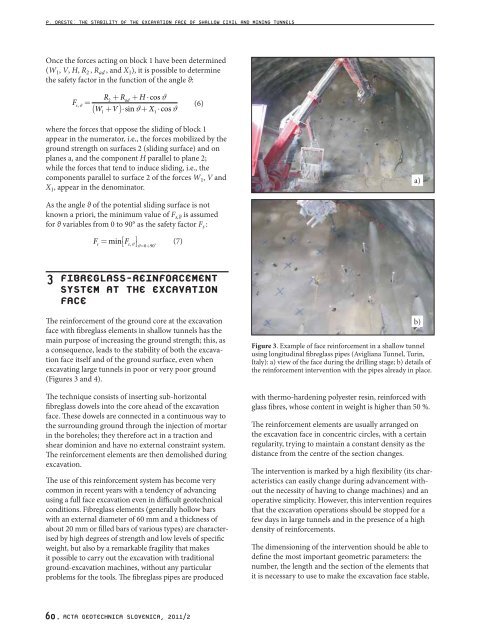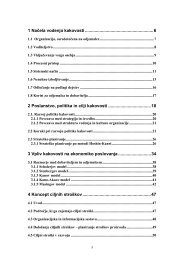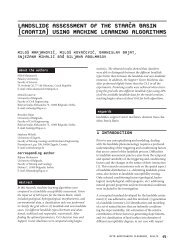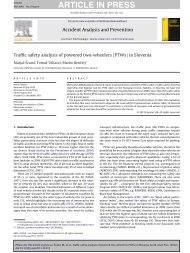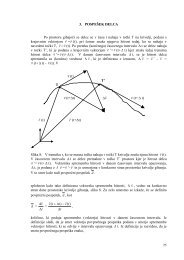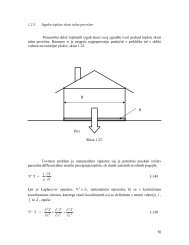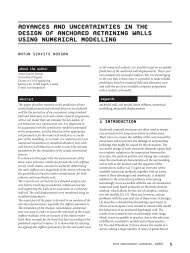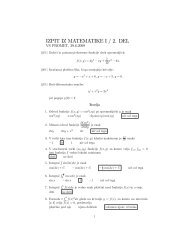The stability of the excavation face of shallow civil and mining tunnels
The stability of the excavation face of shallow civil and mining tunnels
The stability of the excavation face of shallow civil and mining tunnels
Create successful ePaper yourself
Turn your PDF publications into a flip-book with our unique Google optimized e-Paper software.
P. ORESTE: THE STABILITY OF THE EXCAVATION FACE OF SHALLOW CIVIL AND MINING TUNNELS<br />
Once <strong>the</strong> forces acting on block 1 have been determined<br />
(W 1, V, H, R 2 , R ad , <strong>and</strong> X 1), it is possible to determine<br />
<strong>the</strong> safety factor in <strong>the</strong> function <strong>of</strong> <strong>the</strong> angle ϑ:<br />
F<br />
s,<br />
J<br />
R2+ Rad + H⋅cosJ<br />
=<br />
( W + V) ⋅ sinJ+ X ⋅cos<br />
J<br />
1 1<br />
60. ACTA GEOTECHNICA SLOVENICA, 2011/2<br />
(6)<br />
where <strong>the</strong> forces that oppose <strong>the</strong> sliding <strong>of</strong> block 1<br />
appear in <strong>the</strong> numerator, i.e., <strong>the</strong> forces mobilized by <strong>the</strong><br />
ground strength on sur<strong>face</strong>s 2 (sliding sur<strong>face</strong>) <strong>and</strong> on<br />
planes a, <strong>and</strong> <strong>the</strong> component H parallel to plane 2;<br />
while <strong>the</strong> forces that tend to induce sliding, i.e., <strong>the</strong><br />
components parallel to sur<strong>face</strong> 2 <strong>of</strong> <strong>the</strong> forces W 1, V <strong>and</strong><br />
X 1, appear in <strong>the</strong> denominator.<br />
As <strong>the</strong> angle ϑ <strong>of</strong> <strong>the</strong> potential sliding sur<strong>face</strong> is not<br />
known a priori, <strong>the</strong> minimum value <strong>of</strong> F s,ϑ is assumed<br />
for ϑ variables from 0 to 90° as <strong>the</strong> safety factor F s :<br />
= é ù<br />
ë û<br />
(7)<br />
Fs min Fs, J J= 0¸90 3 FIBREGLASS-REINFORCEMENT<br />
SYSTEM AT THE EXCAVATION<br />
FACE<br />
<strong>The</strong> reinforcement <strong>of</strong> <strong>the</strong> ground core at <strong>the</strong> <strong>excavation</strong><br />
<strong>face</strong> with fibreglass elements in <strong>shallow</strong> <strong>tunnels</strong> has <strong>the</strong><br />
main purpose <strong>of</strong> increasing <strong>the</strong> ground strength; this, as<br />
a consequence, leads to <strong>the</strong> <strong>stability</strong> <strong>of</strong> both <strong>the</strong> <strong>excavation</strong><br />
<strong>face</strong> itself <strong>and</strong> <strong>of</strong> <strong>the</strong> ground sur<strong>face</strong>, even when<br />
excavating large <strong>tunnels</strong> in poor or very poor ground<br />
(Figures 3 <strong>and</strong> 4).<br />
<strong>The</strong> technique consists <strong>of</strong> inserting sub-horizontal<br />
fibreglass dowels into <strong>the</strong> core ahead <strong>of</strong> <strong>the</strong> <strong>excavation</strong><br />
<strong>face</strong>. <strong>The</strong>se dowels are connected in a continuous way to<br />
<strong>the</strong> surrounding ground through <strong>the</strong> injection <strong>of</strong> mortar<br />
in <strong>the</strong> boreholes; <strong>the</strong>y <strong>the</strong>refore act in a traction <strong>and</strong><br />
shear dominion <strong>and</strong> have no external constraint system.<br />
<strong>The</strong> reinforcement elements are <strong>the</strong>n demolished during<br />
<strong>excavation</strong>.<br />
<strong>The</strong> use <strong>of</strong> this reinforcement system has become very<br />
common in recent years with a tendency <strong>of</strong> advancing<br />
using a full <strong>face</strong> <strong>excavation</strong> even in difficult geotechnical<br />
conditions. Fibreglass elements (generally hollow bars<br />
with an external diameter <strong>of</strong> 60 mm <strong>and</strong> a thickness <strong>of</strong><br />
about 20 mm or filled bars <strong>of</strong> various types) are characterised<br />
by high degrees <strong>of</strong> strength <strong>and</strong> low levels <strong>of</strong> specific<br />
weight, but also by a remarkable fragility that makes<br />
it possible to carry out <strong>the</strong> <strong>excavation</strong> with traditional<br />
ground-<strong>excavation</strong> machines, without any particular<br />
problems for <strong>the</strong> tools. <strong>The</strong> fibreglass pipes are produced<br />
Figure 3. Example <strong>of</strong> <strong>face</strong> reinforcement in a <strong>shallow</strong> tunnel<br />
using longitudinal fibreglass pipes (Avigliana Tunnel, Turin,<br />
Italy): a) view <strong>of</strong> <strong>the</strong> <strong>face</strong> during <strong>the</strong> drilling stage; b) details <strong>of</strong><br />
<strong>the</strong> reinforcement intervention with <strong>the</strong> pipes already in place.<br />
with <strong>the</strong>rmo-hardening polyester resin, reinforced with<br />
glass fibres, whose content in weight is higher than 50 %.<br />
<strong>The</strong> reinforcement elements are usually arranged on<br />
<strong>the</strong> <strong>excavation</strong> <strong>face</strong> in concentric circles, with a certain<br />
regularity, trying to maintain a constant density as <strong>the</strong><br />
distance from <strong>the</strong> centre <strong>of</strong> <strong>the</strong> section changes.<br />
<strong>The</strong> intervention is marked by a high flexibility (its characteristics<br />
can easily change during advancement without<br />
<strong>the</strong> necessity <strong>of</strong> having to change machines) <strong>and</strong> an<br />
operative simplicity. However, this intervention requires<br />
that <strong>the</strong> <strong>excavation</strong> operations should be stopped for a<br />
few days in large <strong>tunnels</strong> <strong>and</strong> in <strong>the</strong> presence <strong>of</strong> a high<br />
density <strong>of</strong> reinforcements.<br />
<strong>The</strong> dimensioning <strong>of</strong> <strong>the</strong> intervention should be able to<br />
define <strong>the</strong> most important geometric parameters: <strong>the</strong><br />
number, <strong>the</strong> length <strong>and</strong> <strong>the</strong> section <strong>of</strong> <strong>the</strong> elements that<br />
it is necessary to use to make <strong>the</strong> <strong>excavation</strong> <strong>face</strong> stable,<br />
a)<br />
b)


